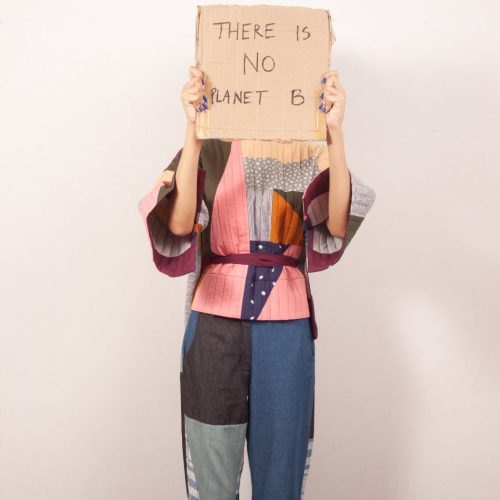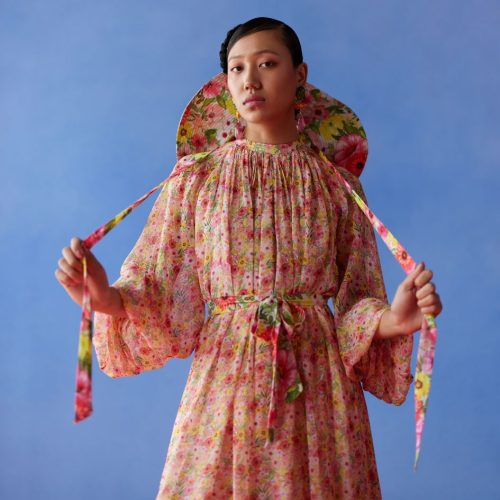- Fashion
Is the #30WearChallenge Really Enough?
- ByManish Mishra

A creation from label Urī that creates “thoughtful garments”, backed by zero waste production, biodegradability, and ethical employment.
While our Instagram feeds may be inundated with pre-loved and restyling posts, how many times do we actually repeat an outfit? According to statistics, on average, garments are only worn seven to ten times before being discarded. This aggravates the quantities of textile waste: 18.6 million tonnes of clothing being thrown away around the world… year after year. In 2015, the #30WearsChallenge campaign was launched by Livia Firth, co-founder Eco-Age (a creative agency specialised in integrated sustainability) and environmental journalist Lucy Siegle, inspiring consumers to ask themselves whether they’d wear a piece a minimum of 30 times before buying.
If you were to wear a piece of clothing only once every week, it would take you over seven months to wear it 30 times. Also, consider the fact that it would have to be of very good quality to be in wearable condition after 30 wears and washes, over several months. So, investing in quality, trans-seasonal pieces is imperative. Bollywood actor Alia Bhatt recently repeated her wedding sari and Kate Middleton in England is often known to restyle her dresses. However, everybody is a stakeholder—from the designers to the supply chains and consumers.

of repairing clothes since its inception in 2012.
Delhi-based fashion journalist Varun Rana, who has always been a proponent of repeating and restyling, observes that initiatives like this are a great way to get people to think. However, he cites that the problem is that we glamorise the time-bound aspect of this initiative more than the core idea behind it. “Sadly, what it leads to is not enough. Nobody is saying, ‘I wore it for 30 days and now I’m inspired to wear it for another 30 years’…and that’s the problem,” he says.
Purchasing is an emotional act—it could be a beautiful print, fabric, or handbag. At that moment, one is not thinking that one would be able to wear it 30 or 40 times. Varun asserts that everything should not be shopped just because it’s repeatable or recyclable. If you can wear something once, you should buy it, nothing should stop you. “The problem is in the way we look at the idea of rewearing and recycling. It should not be just the individual’s responsibility…a sizable number of the population has to do it,” he affirms.
Varun advocates that once you’ve worn something, you should circulate it among your friends. “Nothing is wrong with that; it can give the garment an infinite life. It also allows for new styles to enter your wardrobe; it’s human to get bored after wearing a piece 10 times,” he says.

Stylist and Creative Advisor Ekta Rajani, who’s been documenting her restyling journey on her Instagram page, shares that one can push the challenge beyond 30. “The stats typically show a lot of people, especially women who are living life on social media, are not repeating,” she says.
And so, 30 rewears can become 60. There are people who probably don’t actively belong to the world of social media, whose wardrobes are limited, and are happy to repeat. They’re also not living life for social media Likes. “But the moment you’re living life in a certain way, you begin to get caught up in the pursuit of newness,” Ekta adds. “The number ’30’ should apply to fast fashion buyers because of the low cost, which allows for a few wears with a much higher impact.”
If you go back to the pre-industrialisation age, people would shop only on special occasions. Hence the load on the planet was low. “The fabrics, dyes, and yarns used back then were degradable. With the advent of synthetic yarn, industrialisation, and social media, a different mindset of consumption has emerged,” she adds.
Ekta reiterates that we need to take a very hard look at our consumption patterns and consider the impact on the planet. “Earlier it was about shopping for oneself; now it’s shopping for x number of Likes,” she observes.

social media Likes and the concomitant need for newness.
Varun suggests being conscious of what one is buying. “It takes 30 seconds to Google a brand and see what their production chain looks like. Make informed choices, as per what suits your requirement, purposes, and budget. If it fits with your value system and your level of empathy, buy it,” he says.
Nagpur-based designer Shruti Sancheti, who runs her eponymous, sustainable label, observes that with rapid digitalisation and churning out of trends, the #30wearschallenge is the bare minimum to make mindful purchase decisions. “However, one cannot always apply math to consuming fashion,” Shruti opines. “Instead, one can look for timeless, versatile, season-fluid classics while shopping. I believe each one of us must be responsible and indulge in ethical fashion, and once these criteria are fulfilled, a consumer need not apply rules,” says Shruti.
Whether one wears three or 30 or 300 times is not the issue, according to Shruti. The fact that one indulges in ethical and slow fashion in harmony with environmental and human rights is the solution for a greener planet, which has to be passed on to our next generation. “Because fast fashion is never free, someone does pay a price for it,” she adds.
From a sales perspective, the designer makes an important point: “As designers, our businesses thrive on consumers purchasing our products. However, instead of mindless selling, if we offer customer satisfaction, they will always invest in the brand. We create season-fluid clothes with impeccable finish so that they stay relevant for years.”

is the solution for a greener planet.
Delhi-based Kriti Tula, Creative Director and Founder of Doodlage believes that to keep garments in circulation is extremely important to avoid over-production and consumption of natural resources. “Taking care and repairing clothes is equally important. But repairing has, over time, become associated with being miserly. But it used to be common practice; making your clothes last longer was something we had to do. With more disposable income and cheaper clothes available, repeating and repairing is fading,” Kriti says.
At Doodlage, Kriti works with waste material and, sometimes, it gets hard to figure out the problem or reason for rejection of the material. Kriti upcycles these, however, some materials can deteriorate after a few wears. “As a solution, we offer a lifetime repair service for all our garments,” she adds.
The idea is to encourage people to rewear, hand it down, repair, alter, customise and keep the garment in use for as long as possible.


Hyderabad-based Mrunalini Rao, founder and designer of Urī, observes how social media is influencing fashion, at an extremely fast pace, which is leading to a huge rise in purchase volumes. “From everyday fashion to bridal, including expensive fine jewellery, the volumes have gone really high,” she asserts.
Urī was one such label that had come to life in 2021 to create conscious fashion, backed by zero waste production, biodegradability, and ethical employment. “One should invest in clothing that they can wear comfortably at any occasion, and can even swap with their mother/daughter/friends. It should be something that is evergreen and can be styled in different ways,” she says.


piece in different ways to get more wears out of it.
And Neha Singh, C0-founder and designer of Delhi-based label Cord says, “A 30-wear test is not enough; one should only invest in garments that are timeless and can become your best friends.”
When one buys a beautiful, trans-seasonal piece, one can’t put a number to its usage because that purchase is not based on social media Likes. It makes sense to invest in pieces that are not only crafted to suit multiple occasions, but can be worn everyday, providing you a sense of comfort with luxury through their organic materials.

READ MORE
- Gauri Khan, On Her New Experience Centre In Delhi, Her Favourite Spot At Home, and Great Décor Advice
- With IRTH’s New Store in Noida, The Brands Adds To Its Joyful Delights
- Ranbir Kapoor’s New Perfume, ARKS Day, Reminds Him of His Childhood
- Your Interiors Will Love The Colour and Design Predictions By Asian Paints’ ColourNext Forecast for 2025
- “India is an Incredible Source of Inspiration for Me, and I Want to Connect With the Hearts of Indian Women”





